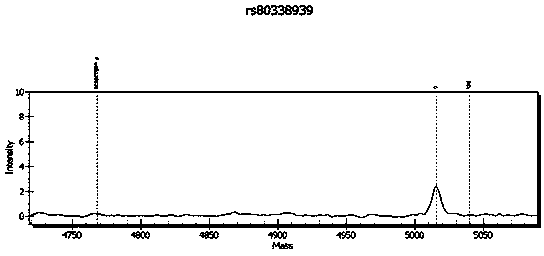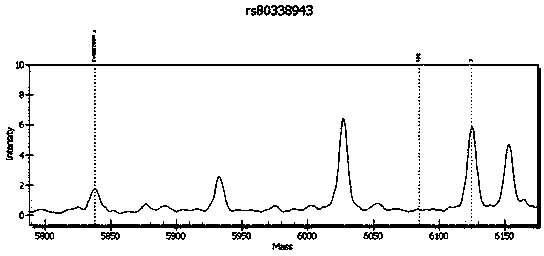Primer system for detecting gene SNP related to genetic deafness, and use thereof
A hereditary deafness and gene technology, applied in the field of test kits, can solve the problems of inability to cover deafness susceptibility gene loci, high cost, and limited detection ability.
- Summary
- Abstract
- Description
- Claims
- Application Information
AI Technical Summary
Problems solved by technology
Method used
Image
Examples
Embodiment 1
[0077] Example 1: Primer design and synthesis.
[0078] 针对GJB2基因rs80338939(35delG)、GJB2基因176del16、GJB2基因rs80338943(235delC)、GJB2基因rs111033204(299delAT)、GJB3基因rs74315319(538C>T)、GJB3基因rs74315318(547G>A)、SLC26A4基因rs121908362(2168A> G), SLC26A4 gene rs111033313 (IVS7-2A>G), mit12S rRNA1494C>T, mit12S rRNA1555A>G and other 10 gene polymorphic sites related to hereditary deafness were designed corresponding to specific PCR primer core sequences (SEQ ID No: 1 to SEQ ID No: 20) and specific extension primer core sequences (SEQ ID No: 21 to SEQ ID No: 30).
[0079] Among them, in order to prevent PCR primers from entering the detection window of the mass spectrometer and interfering with the detection effect, a certain number of bases can be added to the core sequence (SEQ ID No: 1 to SEQ ID No: 20) at the 5' end of each PCR primer , such as a 10bp tag (ACGTTGGATG), to increase the molecular weight of the PCR primers, thereby exceeding the detection window of the mass spectrometer. ...
Embodiment 2
[0080] Embodiment 2: sample DNA extraction.
[0081] A total of 10 deaf patients were collected. Among them, sample collection, DNA extraction, etc. were collected in accordance with the requirements of the instructions, and human venous blood was collected with EDTA anticoagulant tubes. According to the instructions, the collected blood should not be stored at 2-8°C for more than one week, and at -20°C for no more than one month, and can be transported in a curling box with ice or a foam box with ice. It is recommended to use fresh blood as much as possible. Genomic DNA extraction. Since this kit does not provide human genomic DNA extraction reagents, a commercial nucleic acid extraction kit (such as QIAGEN’s DNeasy Blood and Tissue kit) was used to extract human genomic DNA from 200ul whole blood of each patient, and the DNA was extracted using NanoDrop2000 ( Thermo company) and standardized to 30ng / ul (A1-A10 respectively). Among them, the kit is recommended to detect hu...
Embodiment 3
[0082] Embodiment three: Biological experiment.
[0083] Using ABI9700 PCR instrument, according to the instructions, 10 genetic polymorphic sites related to hereditary deafness were tested.
[0084] The components used in the kit for PCR, PCR product purification and single base extension are:
[0085] serial number
component name
main ingredient
Specification
1
PCR Primer Mix
PCR primers
24ul / tube xl tube
2
PCR reaction solution
Taq enzyme, dNTP
72ul / tube xl tube
3
Enzyme digestion reaction solution
SAP enzyme
48ul / tube xl tube
4
Extension Primer Mix
extended primer
24ul / tube xl tube
5
Extension reaction solution
Single base elongase, ddNTP
24u1 / tube xl tube
6
Human Genomic DNA (3Ong / ul)
10ul / tube xl tube
[0086] The concentration of each primer pair is 500nmol / L.
[0087] According to the manual, the specific opera...
PUM
 Login to View More
Login to View More Abstract
Description
Claims
Application Information
 Login to View More
Login to View More - R&D
- Intellectual Property
- Life Sciences
- Materials
- Tech Scout
- Unparalleled Data Quality
- Higher Quality Content
- 60% Fewer Hallucinations
Browse by: Latest US Patents, China's latest patents, Technical Efficacy Thesaurus, Application Domain, Technology Topic, Popular Technical Reports.
© 2025 PatSnap. All rights reserved.Legal|Privacy policy|Modern Slavery Act Transparency Statement|Sitemap|About US| Contact US: help@patsnap.com



